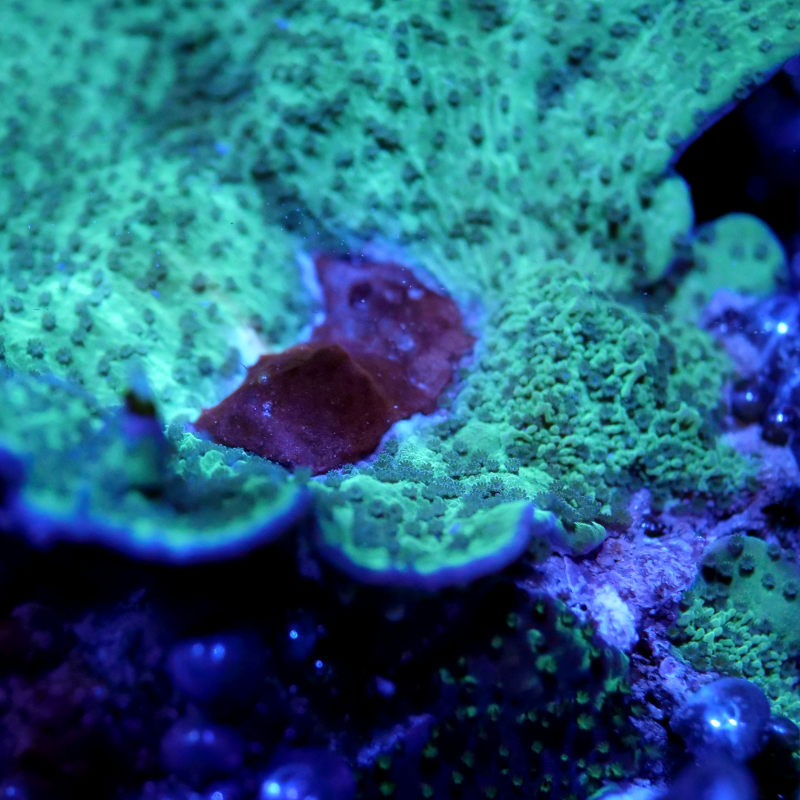HOW TO FIGHT CYANOBACTERIA

Cyanobacteria form red or green mat-like deposits that, if the infestation is very severe, can completely cover both the substrate and the stone structures in your aquarium. They don't even stop at corals and other stuck organisms. But it doesn't have to come to that. If you act early, you'll soon get the problem under control again.
We give you five tips on how to combat unsightly cyano deposits:
#1 Vacuum cyano deposits regularly
If cyanobacteria have already spread in your aquarium, you should try to repeatedly vacuum the reddish deposits. You must dispose of the resulting 'waste water'! To avoid losing too much tank water, use a hose that is as thin as possible. It can take quite a while for regular vacuuming of the deposits to have an effect. The key here is to stay calm and vacuum, vacuum and vacuum again!
Cyanobacterial deposits like these are no reason to panic. Often, vacuuming and adding bacteria is enough to get the problem under control.
#2 Bacteria against Cyanos
Cyanobacteria are particularly common in aquariums that are biologically unstable. In this context, biologically unstable means that there is no functioning bacterial community (yet). Many "good" bacteria in your aquarium compete with the cyanobacteria and thus limit their development. The use of live rock or special bacterial solutions such as Nitribiotic are beneficial here. The addition of bacterial solutions is particularly effective if you introduce them directly into the substrate using a syringe and a cannula.
#3 Phytoplankton against cyanobacteria
Similar to the use of bacteria, phytoplankton can also compete with cyanobacteria and limit the spread of deposits. Live phytoplankton of the genus Synechococcus sp. (which is itself a cyanobacteria, but does not form deposits and is "good" for the tank biology) has proven to be particularly effective.
#4 Avoid “rotten corners”
Cyanobacteria love "rotten corners" and therefore tend to appear in places where a lot of sludge accumulates due to a weak or non-existent flow. It can help to improve the flow pattern in your tank. Try to realign your pumps or increase their performance a little. If this is not possible, you can consider using additional pumps or replacing them with stronger ones. You should also remove sludge from the substrate in your tank at regular intervals. It is best to use a sludge bell for this.
Corners that are not very clean, areas with little flow and dead coral skeletons are places where cyanobacteria particularly like to grow. Keep an eye on these so that you can react quickly when the first cyanos appear.
#5 Check and optimize your water values
A wide variety of parameters can promote the growth of cyanobacteria. Some cyano species benefit when no nutrients are detectable in the water. Other species have the ability to absorb molecular nitrogen from the environment and fix it in the form of ammonium. In the case of a nitrogen deficiency and a simultaneous phosphate excess, such cyanobacteria have a real advantage. Therefore, ensure a balanced nitrate:phosphate ratio (ideally 1:100) and, if necessary, increase the nutrients slightly above the detection limit. Increased phosphate concentrations can be reduced by using a phosphate adsorber.
#6 Supportive measures
If possible, avoid adding carbon (e.g. vodka method, products with ethanol or sugar as ingredients) while the cyano problem exists, as this generally promotes bacterial growth (including that of cyanobacteria). In addition, you should temporarily stop adding trace elements and amino acids. Additional filtration using activated carbon can be useful to remove possible cyanobacterial toxins. Also check your silicate content in the water again and take measures if necessary (e.g. replace the mixed bed resin of the osmosis system) to remove silicate.
#7 The last resort
If you have taken all the measures listed here but have not seen any improvement after several weeks, you can consider using an anticyano preparation. There are numerous options available on the market. However, you should make sure that the preparation does not contain antibiotics. Since the use of antibiotics often has a severe impact on the pelvic biology, antibiotic preparations should be considered the last option. If you decide to use them anyway, it is recommended that you stabilize the pelvic biology after treatment by adding a bacterial solution.
We hope that these tips will help you get rid of your cyanobacteria and that you will soon be able to enjoy your aquarium to the fullest (cyano-free) again. The most important thing is: react early and stick with it!

.JPG)







